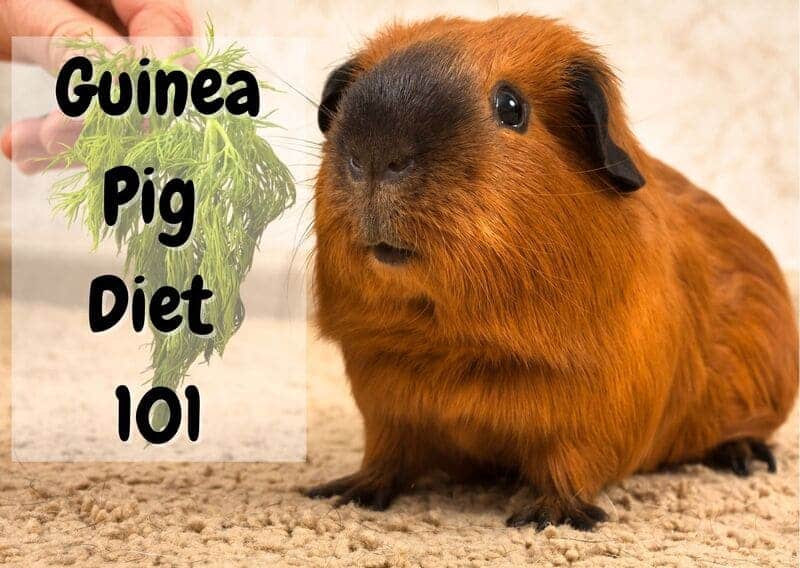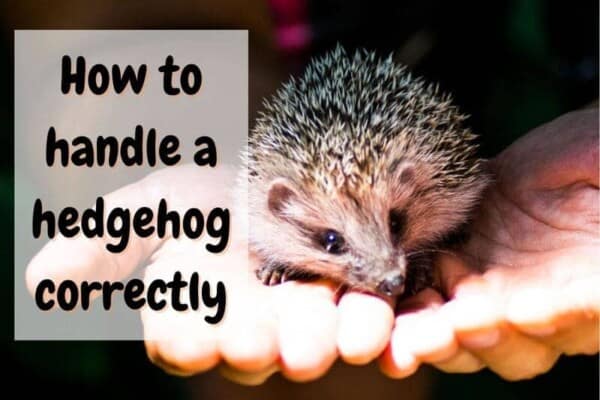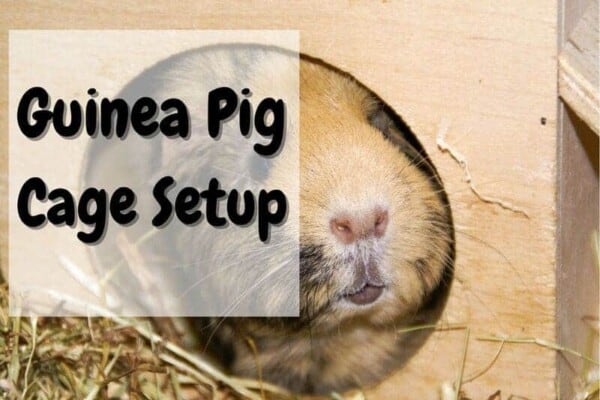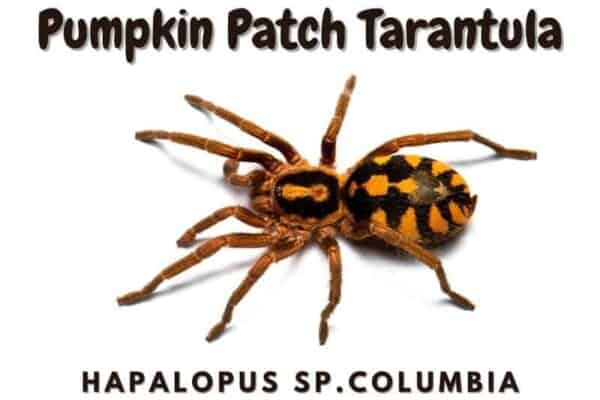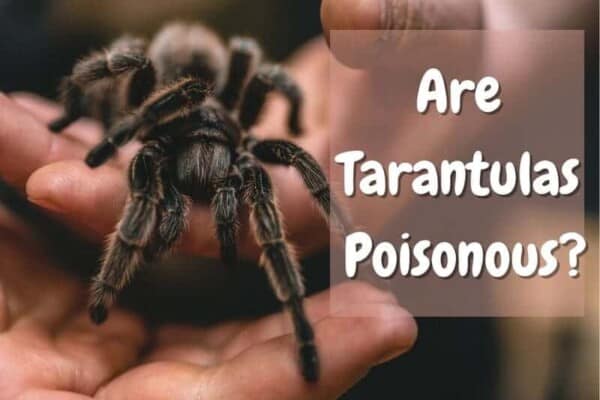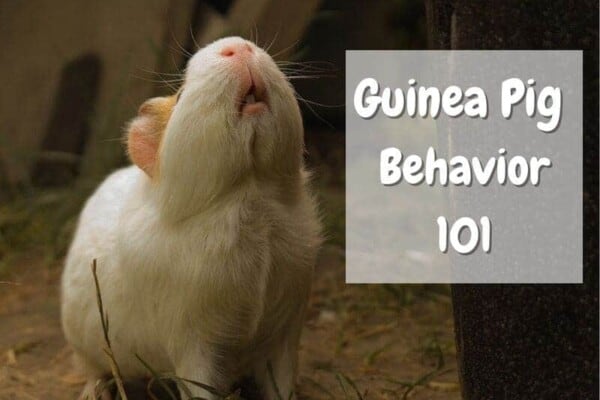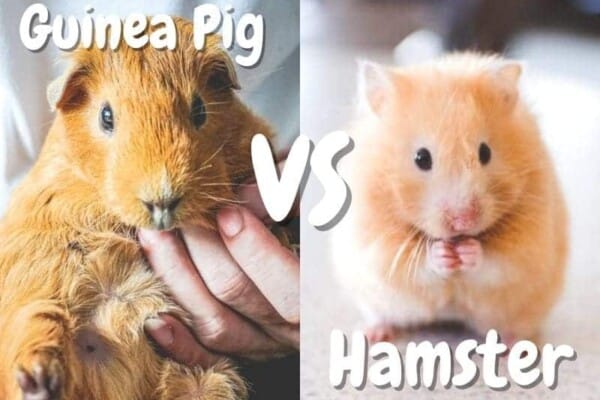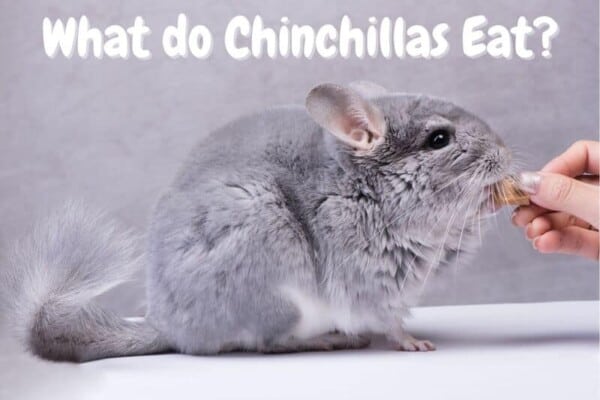One of the most common questions new guinea pig owners ask is “What can I give my guinea pigs to eat? What type of food should I avoid?” Because they are herbivores, their basic diet includes a wide variety of fresh vegetables, hay and grass, and Vitamin C supplements from pellets.
In this guide, you will learn everything there is to know about the guinea pig diet. You will know what food they should and should not eat, what fruits and vegetables they can be given, and which ones should be avoided. You will also learn how to prepare some tasty treats to reward a happy cavy.
Food Your Guinea Pig Can Eat – A Complete List
1. Vegetables
There are numerous kinds of fresh veggies that are excellent for feeding your guinea pig. They do need to be cut up into small pieces and served as a mixture. This way, they get a good variety of Vitamin C and other essential vitamins.
- Carrots
- cabbage/ red cabbage,
- types of green lettuce (no iceberg),
- zucchini,
- celery,
- spinach,
- arugula,
- kale,
- turnip/turnip greens,
- Swedish turnip (rutabaga),
- tomatoes (no stems or leaves),
- Broccoli,
- asparagus,
- cauliflower,
- corn on the cob/baby corn,
- green beans,
- peas, squash,
- pumpkin,
- watercress,
- Swiss chard,
- beetroot,
- collard greens,
- red bell pepper,
- sprouts.
2. Fruits
- Pears,
- blueberries,
- cucumber
- apples,
- bananas,
- grapes,
- raspberries,
- oranges,
- pineapple,
- plums,
- strawberries,
- kiwi,
- papaya,
- mangoes,
- peaches,
- apricot,
- nectarine,
- cherries (sweet and sour),
- cranberries,
- watermelon,
- Passionfruit
3. Herbs and flowers
- Thyme,
- dandelions,
- mint, cilantro,
- parsley,
- dill,
- basil,
- endive,
- marigold,
- rosehips (shells only),
- anise,
- caraway,
- cleavers/clovers,
- Chickory,
- duckweed,
- dried nettle,
- peppermint,
- wheatgrass
4. Cereals/nuts
- Cheerios,
- rice Krispies,
- shredded wheat (unfrosted),
- corn flakes,
- oats,
- oatmeal,
- chopped almonds
5. Grass
- Timothy hay: This is often the go-to type of hay for all sorts of small animals like chinchillas and rabbits. This perennial grass is high in fiber and low in protein and calcium. It’s also ideal for little animals because it has a strong aromatic smell that is irresistible to them. This hay is considered ideal since it helps with digestion and dental health.
- Bermuda hay: It’s grown in the southern regions of the US and is harvested in the spring. It’s commonly given to horses because it has higher amounts of calcium than Timothy hay. It has a modest amount of protein and is high in fiber content. It’s a great high-fiber all-day food for your guinea pig.
- Orchard hay: This hay is typically grown in the Pacific Northwest of the US and is also high in fiber for small pets. It’s a good substitute for animals that have allergies to Timothy hay. It can be used as a food source and bedding. It’s very high in fiber but low in protein with a sweet smell that is appealing to all kinds of hay-eating pets. It promotes very good digestion and dental health in addition to encouraging their appetite. The leaves are softer than Timothy hay and pack more hay per package than most commercially packaged products.
- Oats hay: This is a different kind of hay that offers long strands of dry grass with oats growing on each end. This is perfectly fine for your guinea pig, but not as a stable diet all the time. Consulting with your vet, this hay can be good for recovering guinea pigs that were sick. Because it has higher amounts of protein, fat, and fiber, it will be packed with more nutrients than any of these choices. This is another reason why it could be beneficial for cavies that have lost weight. This can be a great supplement for guinea pigs that need additional and short-term high-energy food.
- Meadow hay: Meadow hay is a bit like potpourri for your guinea pig. It includes lots of flowers, grasses, and seed heads that are grown in meadow fields. This mixture of grass and various additives is packed with nutrients and should have a green appearance. The various types of grass and flowers have lots of nutrients and various textures. It helps promote good dental health and excellent digestion. This type of hay is good for owners who want to give their guinea pigs variety rather than a single hay brand.
6. Pellets
Pellet food is considered a food source but is not the actual food that your guinea pig should be eating all day. These pellets are processed to be compact little rounded sticks. They are easy for your guinea pig to hold and don’t present a choking hazard. These can be a combination of these grasses or sticking to a specific strain. The three most common flavors of pellets will be:
- Timothy hay
- Alfalfa hay
- Clover hay
What is the balance between pellets and natural food you might ask? Well, it’s easy to assume that your guinea pig is going to spend most of its day eating hay. Their feeding time does complement the food that is given in the form of pellets, fresh vegetables, and some types of fruits.
The best pellets are the ones that include compacted hay from various types of grass such as Timothy and alfalfa grass. You might see clover mixed into these to add flavor and nutrients. Try to avoid any pellets that are mixed with additives or snacks that are not recommended for your guinea pig.
7. Chewing snacks
It won’t be uncommon that your guinea pig will like to chew on wood to keep its teeth from growing too long. As long as you include wood that is not treated and is all-natural, the wood they chew is safe for them. Here is a list of wood that is considered safe for them to chew:
- Applewood sticks,
- Aspen.
- Spruce,
- Beech,
- Bamboo,
- Birch,
- Pine,
- Fir,
- Oak,
- Whitewood,
- Balsawood
Can guinea pigs eat other pet foods?
If you run out of viable food to give your guinea pig, you need to be careful what kind of food you substitute. A bad example would be dry cat food since this food is high in protein and can make them very sick. The same would apply to dry dog food, as this doesn’t give enough fiber.
If you want to give them a food substitute, the food meant for hamsters or chinchillas is perfectly fine, as long as it’s a high-end fiber pellet. Hamster food can contain seed and corn that isn’t healthy for your guinea pig so these pellets should be picked out.
What to give to a baby guinea pig for food
Pet stores will start selling baby guinea pigs when they are about 6 weeks old. They will be ready to eat the regular food the adults eat at this point. Since they are smaller, the serving portions don’t need to be more than a tablespoon or so of pellets and veggies.
The veggies will need to be cut down so they can be swallowed easier. Pea-sized portions are advised since they are smaller than adults. We recommend this size even for adults since these are easily held in their little hands.
They will get used to this and have a better time sorting through a food dish to pick out what they like. At this age, you will get to see what they are learning more through smell and taste. Make careful notes on what these are so you will have better luck creating a rounded menu for their feeding times.
Guinea pig diet Do’s and Don’ts
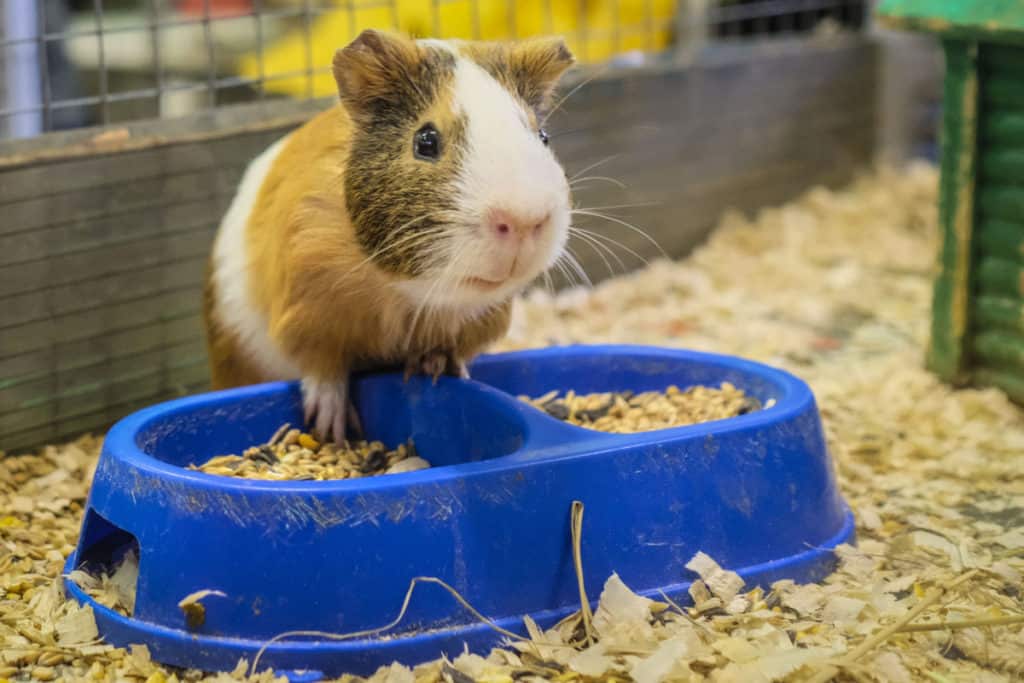
Don’t feed your guinea pig these foods
- chives,
- potatoes/sweet potatoes,
- lavender,
- lawn grass (may contain parasites),
- sage,
- onions,
- garlic,
- chili peppers,
- shallots/leeks,
- chamomile,
- tarragon,
- fennel,
- Rosemary,
- oregano,
- yarrow,
- daffodil,
- sunflowers,
- chickweed,
- goldenrod,
- sweet peas,
- mushrooms,
- asters,
- nasturtiums
- mallow,
- tomato leaves and stems/unripe tomatoes,
- rhubarb,
- avocado,
- Bok Choy,
- seeds/fruit seeds/pits,
- buttercup flowers,
- rice,
- whole wheat,
- popcorn,
- dairy products,
- bread,
- cooked meat.
Only give your guinea pigs fresh fruits and vegetables
Guinea pigs like fresh veggies that are the same level of freshness you and I enjoy eating. Even though these veggies need to be cut into smaller pieces, they should be freshly sliced and not soft or rubbery. While they might be nice for soup or to be used as compost, they shouldn’t be fed to your pet.
1. Obesity
Guinea pigs are prone to eating too much and they gain weight quickly. Keeping a balanced diet will keep them healthy with a good amount of activity and exercise. Over their lifetime they will have different eating habits, so you will need to adjust to these stages. As they grow from little pigs to adults in a matter of months, they will need increased amounts of scheduled food.
2. Toxic foods
Many people forget that the grass in your yard has all sorts of toxins in it. It can also contain parasites that will cause health problems that may require a visit to the vet. If you treat your lawn with fertilizers, this can also be toxic for your pet to eat.
Also, keep in mind that fresh-cut grass clippings are bad for their stomach no matter what most guinea pig websites are saying. If you’re going to let your guinea pig go outdoor, make sure it’s not anywhere near plants, grass, and ivy.
3. Servings that are too big
Your guinea pig has very limited space in its throat for allowing little bits of food to pass. Large fresh veggies and bits of food that are not cut up into pea-sized bits are a choking hazard.
Guinea Pig Feeding: How often, How Much, and When?
- How often: Giving them food once a day is perfectly fine for your guinea pigs. If you have a growing guinea pig, you can try feeding them twice a day with a reduced amount of pellets and a mixture of fresh vegetables and some fruits. Since fruits have natural sugars, this is a source of added fat that can make your guinea pig overweight. These can be given as treats, but not very often. If they get used to these sweets, they might be less inclined to eat their hay or pellets.
- How much: Start with 2 tablespoons of pellets per day for an adult and one tablespoon for little guinea pigs. Then there will be 1-2 tablespoons of mixed veggies of your choice. These need to be chopped down into pea-size pieces and must be fresh. If you need to store veggies in the fridge, put them in plastic containers or in the crisper so they last longer. Some veggies need to have the skin taken off such as cucumber and zucchini.
- When: The best time is in the morning or when you wake up. This schedule should remain constant so they will get used to this eating time. A second time later at night should be followed by activity games and exercise for them. As they get bigger, they will need more food that gives them energy. Keeping their diet continual, you can adjust vegetables to see what they like to eat. This will give you an idea of what their established diet will be.
Guinea Pig Treats
Guinea Pigs love fruits but they should be the kind that does not have any kinds of seeds inside them. Examples such as apples, watermelons, and fruit pits need to have their seeds removed beforehand. The only exception is tomato and cucumber seeds which are edible for them.
You may also prepare hand-made cookie treats that are a mix of selected fruits and oatmeal. Blend everything into a puree and bake them in a preheated oven at 180 degrees Celsius for about 10 minutes or until they are crispy on top. You may give them to your guinea pigs once the treats have cooled down.
How often can you give them treats?
If you decide on fruits, these need to be in limited quantities at most. You don’t want to upset their stomach with natural sugars that could cause weight gain or tooth decay. Once or twice a day with one or two little pieces is more than enough as a treat.
These will be given when you serve their food in the morning and at dinner time. If you have two feeding times per day, you need to reduce the servings so they are better for their digestion.
Treats that are higher in sugar like hand-made cookies can be kept in a small plastic container in the fridge and given two or three times a week to avoid disrupting their normal hay-feeding habits.
What and how do guinea pigs drink?
A guinea pig drinks simple tap water and won’t be picky whether it is bottled or not. The kind of minerals that come from tap water won’t hurt them, so feel free to give them fresh tap water to drink.
You need to include some drinking recipients when setting up your guinea pig cage. You can either put this water in a bowl or in a water dispenser, which both have their pros and cons.
Bowl
Your guinea pig will learn to drink from a bowl if they are not keen to use a water bottle. It’s more work keeping the water bowl clean than using a bottle, so you need to change it more often. Also, keep in mind that guinea pigs are very energetic creatures that can knock all sorts of stuff into the water while they are scampering around in their cage.
A water bowl can also be better for them if they have been sick or are just lazy to get a drink. Lifting their head up to a water bottle would be too much effort for a lazy guinea pig. In general, lazy guinea pigs will be more inclined to use a water bowl.
Dispenser
If you do decide to get a water bottle, this is a good backup if you have more than one guinea pig. Some pigs might prefer using the bottle if one of them is hogging the water bowl. If they run out of water, be sure to refill the bottle as soon as possible.
The bottle itself can be plastic but we recommend using a glass one instead. If they decide to chew on the plastic, that bottle is ruined. Glass bottles are ideal because they will last longer and it will be easier to clean off possible germs or bacteria.
How often should guinea pigs drink?
Your guinea pig is a thirsty little critter that can consume up to 80 or more milliliters of water per day. This is 5 tablespoons of water per day or more. So have a water bowl or bottle that can store a minimum of 100 milliliters or more.
If it gets empty because you own more than one guinea pig, refill it as soon as possible. Putting several bottles around the cage will help too. You don’t want to have a pig that becomes dehydrated because it ate too much hay and has no water to wash it down.
What do guinea pigs eat in the wild?
Back in the days when the wild guinea pig roamed the earth, they hunted down unsuspecting plant life. Whatever came in their path including leaves, grasses, and fruits was quickly gobbled down. Their nature didn’t stop at the surface as they also ate roots, floral greens, and dried grass along the way. Luckily, through modern science, many professional zoos have recreated their natural habitat.
How long can a guinea pig go without eating?
A guinea pig can’t go more than 7 or 8 hours without eating. After 24 hours their stomach ceases to digest food. This is a very bad sign and can lead to their death if they don’t get to a vet for an infusion.
Chances are slim for these little ones since they seldom recover from being starved up to this point. After 10 hours there is still time to get them back to normal, but not without a hefty vet bill. Always make sure they have hay and water in their cage for this reason.
Related articles:
- Guinea Pig grooming tips – How to groom a guinea pig like a pro
- Are Guinea Pigs nocturnal? Guinea Pig sleep pattern explained
References and further reading:
- Nutrient Requirements of Laboratory Animals: Fourth Revised Edition, 1995.
- Nutritional value of some raw materials for guinea pigs (Cavia porcellus) feeding, Jorge Castro-Bedriñana and Doris Chirinos-Peinado
- Diet Composition and Mineral Balance in Guinea Pigs, B. L. O’Dell, E. R. Morris, E. E. Pickett, A. G. Hogan
Contents
- Food Your Guinea Pig Can Eat – A Complete List
- Can guinea pigs eat other pet foods?
- What to give to a baby guinea pig for food
- Guinea pig diet Do’s and Don’ts
- A few typical diet-related issues in guinea pigs
- Guinea Pig Feeding: How often, How Much, and When?
- Guinea Pig Treats
- What and how do guinea pigs drink?
- What do guinea pigs eat in the wild?
- How long can a guinea pig go without eating?

